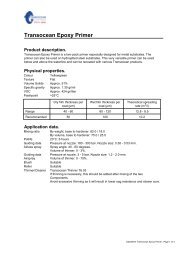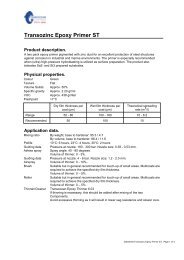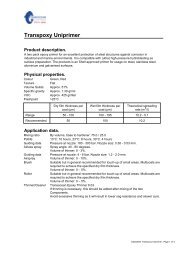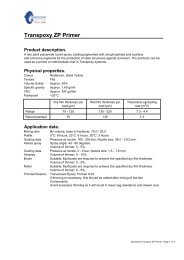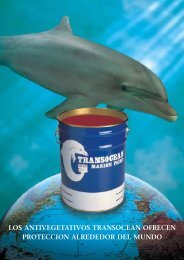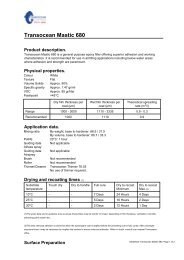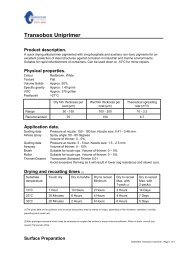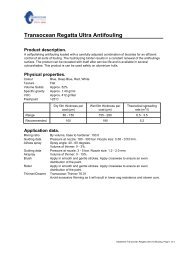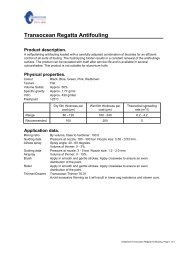Product Data Sheet Transpoxy MIO Primer 164 - Transocean Coatings
Product Data Sheet Transpoxy MIO Primer 164 - Transocean Coatings
Product Data Sheet Transpoxy MIO Primer 164 - Transocean Coatings
Create successful ePaper yourself
Turn your PDF publications into a flip-book with our unique Google optimized e-Paper software.
<strong>Transpoxy</strong> <strong>MIO</strong> <strong>Primer</strong> <strong>164</strong><strong>Product</strong> description.A two-pack polyamide cured epoxy coating pigmented with micaceous iron oxide. The productoffers good resistance against abrasion and impact. The cured coating provides an excellentbarrier against penetration of water and watervapour. The product can be used as a primer orintermediate coat in <strong>Transpoxy</strong> systems. The product offers resistance against dry heat up to200°C.Physical properties.ColourSilvergreyTextureFlatVolume Solids Approx. 57%Specific gravity Approx. 1.64 gr/mlVOCApprox. 340 gr/literFlashpoint >25°CDry film thickness percoat (µm)Wet film thickness percoat (µm)Theoretical spreadingrate (m 2 /l)Range 75 - 125 130 - 220 7.6 - 4.6Recommended 75 130 7.6Application data.Mixing ratio By volume, base to hardener: 80.0 / 20.0Potlife10°C: 6 hours, 23°C: 4 hours, 30°C: 2 hoursGuiding data Pressure at nozzle: 180 - 250 bar. Nozzle size: 0.38 - 0.53 mm.Airless spray Spray angle: 40 - 80 degrees.Volume of thinner: 0 - 5%.Guiding data Pressure at nozzle: 3 - 5 bar. Nozzle size: 1.5 - 1.8 mm.Airspray Volume of thinner: 0 - 10%.BrushSuitable. Multicoats are required to achieve the specified dry film thickness.Volume of thinner: 0 - 5%.RollerSuitable. Multicoats are required to achieve the specified dry film thickness.Volume of thinner: 0 - 5%.Thinner/Cleaner <strong>Transocean</strong> Epoxy Thinner 6.03If thinning is necessary, this should be added after mixing of the twoComponents.Avoid excessive thinning as it will result in lower sag resistance and slower cure.<strong>Data</strong>sheet <strong>Transpoxy</strong> <strong>MIO</strong> <strong>Primer</strong> <strong>164</strong>, Page 1 of 4.
Drying and recoating times (1)SubstratetemperatureTouch dry Dry to handle Full cure Dry to recoatMinimumDry to recoatMax.(2)10°C 12 Hours 24 Hours 14 Days 24 Hours Indefinite23°C 6 Hours 12 Hours 7 Days 12 Hours Indefinite30°C 4 Hours 10 Hours 4 Days 8 Hours Indefinite(1)The given data are for guidance only as actual drying times may be shorter or longer, depending on film thickness, ventilation, humidity,preceding paint system etc.(2)The best intercoat adhesion is achieved when the subsequent coat is applied before the preceding coat is fully cured. After prolongedexposure times it may be necessary to roughen the surface to ensure intercoat adhesion. When in doubt, consult your nearest <strong>Transocean</strong>office.Surface PreparationSteel - Blast CleaningAll surfaces should be clean, dry and free from contamination. Surfaces should be treated inaccordance with ISO 8504:2000.All edges shall be ground to a minimum radius of 2 mm. Remove weld spatter and smooth weldseams by using disc grinders, chipping hammers or other suitable power tools. Sharp edges, weldseams, corners and other areas that are likely to receive less dry film thickness than specified,should be stripe coated.The surfaces shall be blast-cleaned to min. Sa 2½ (ISO 8501-1:2007). The surface profile and theanchor pattern shall be between 40 µm and 70 µm.The abrasives shall be free from oil, grease, moisture, chloride contamination etc.Stainless SteelAll surfaces should be clean, dry and free from contamination. Surfaces should be treated inaccordance with ISO 8504:2000.Blast cleaning shall be carried out by smooth sweep blasting, using a fine non-iron containingabrasive (e.g. aluminium oxide). The abrasives shall be free from oil, grease, moisture, chloridecontamination etc.Surface roughness shall be in the range of 20 µm to 30 µm.Minor repair / Touch-upAll surfaces should be clean, dry and free from contamination. Surfaces should be treated inaccordance with ISO 8504:2000.Any corroded areas should be prepared by power-tool cleaning or water jetting.Power-tool cleaning to min. St 2, preferably St 3 (ISO 8501-1:2007). Care shall be taken to ensurethat power-tool cleaning does not polish the steel surface. If the surface being prepared liesadjacent to a coated surface, the power tool cleaning shall overlap the coated surface by at least25 mm and the coated surface shall be feathered.Water jetting in accordance to ISO 8591-4: 2006 to a cleanliness of Wa 2 or better for atmosphericexposure. Acceptable flash rust degree is M (medium) but degree L (light) is preferred.A water pressure of at least of 1000 bar (approx. 15.000 psi) is recommended.Contact your local <strong>Transocean</strong> office for more information.<strong>Data</strong>sheet <strong>Transpoxy</strong> <strong>MIO</strong> <strong>Primer</strong> <strong>164</strong>, Page 2 of 4.
Major Repair/ RefurbishmentAll surfaces should be clean, dry and free from contamination. Surfaces should be treated inaccordance with ISO 8504:2000.Corroded areas to be prepared by blast cleaning or water jetting.Blast Cleaning: The surfaces shall be blast-cleaned to min. Sa 2½ (ISO 8501-1:2007). Theabrasives shall be free from oil, grease, moisture, chloride contamination etc.Water jetting: Water jetting in accordance to ISO 8591-4: 2006 to a cleanliness of Wa 2,5.Acceptable flash rust degree is M (medium) but degree L (light) is preferred.A water pressure of at least of 1000 bar (approx. 15.000 psi) is recommended.Alternatively a suitable priming system can used. When recoating zinc primed products, ensure theprimer has been fully cured. Zinc salts products shall be removed by high pressure fresh watercleaning. Contact your local <strong>Transocean</strong> office for more information.Coated substratesAll surfaces should be clean, dry and free from contamination. Surfaces should be treated inaccordance with ISO 8504:2000.Ensure compatibility of the coated substrates with the selected paint system. If the remaining partof the existing coating system needs to be sweep-blasted, fine abrasive shall be used to avoiddamage to the coating system.When recoating aged coated substrates, damaged areas must be removed back to a firm edge.Light abrade or sweep-blast the surface in order to provide a physical key for adhesion.When recoating zinc primed products, ensure the primer has been fully cured. Zinc salts productsshall be removed by high pressure fresh water cleaning.Contact your local <strong>Transocean</strong> office for more information.Typical paint systemA typical system for this product is shown below and should be taken for guidance only. A fullsystem specification where all details are taken into consideration can be obtained through yourlocal <strong>Transocean</strong> representative.<strong>Transpoxy</strong> <strong>MIO</strong> <strong>Primer</strong> <strong>164</strong> Recommended: 75µm DFT<strong>Transpoxy</strong> Intermediate Recommended: 100µm DFTTransurethane Finish Recommended: 40µm DFTApplication conditionsThe temperature of the substrate should be at least 3°C above the dew point of the air.Temperature and relative humidity should be measured in the vicinity of the substrate.The maximum recommended surface temperature is approx. 40°C. Higher steel temperatures areacceptable provided dry-spray is avoided by proper spray application and extra thinning if required.In extreme cases it may be necessary to reduce film thickness in order to avoid sagging.When applying the paint in confined spaces, provide adequate ventilation during application anddrying.The temperature of the mixed paint should be at least 15°C, otherwise extra solvent may berequired to obtain a proper application viscosity.Storage and shelf lifeThe product must be stored in accordance with national regulations. The cans are to be kept in adry, cool, well ventilated space and away from source of heat and ignition. Cans must be kepttightly closed.Worldwide availabilityThe product is part of the common <strong>Transocean</strong> product range but local availability is subject toconfirmation. Although we strive to supply the same product through the world, slight modificationsof the product in some cases may be necessary in order to comply with local conditions and/ornational regulations. In such cases an alternative datasheet will issued.<strong>Data</strong>sheet <strong>Transpoxy</strong> <strong>MIO</strong> <strong>Primer</strong> <strong>164</strong>, Page 3 of 4.
Health and safetyObserve the precautionary notices on the label of the container. A material safety data sheet isavailable upon request and national or local safety regulations should be followed. This product isintended for use by professional applicators.As a general rule, avoid skin- and eye contact by wearing overalls, gloves, goggles, mask, etc.Spraying should be carried out under well-ventilated conditions. This product contains flammablematerials and should be kept away from sparks and open flames. Smoking in the area should notbe permitted.DisclaimerThe information in this data sheet is provided to the best of our knowledge. However, we have nocontrol over either quality or condition of the substrate and other factors affecting the use andapplication of this product. Therefore, we cannot accept any liability whatsoever or howsoeverarising from the performance of the product or for any loss or damage arising from the use of thisproduct. We reserve the right to change the product without notice.MID Number: <strong>164</strong>-1001Date of issue: April 2014<strong>Data</strong>sheet <strong>Transpoxy</strong> <strong>MIO</strong> <strong>Primer</strong> <strong>164</strong>, Page 4 of 4.



